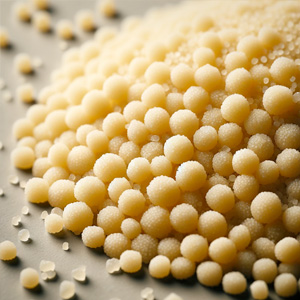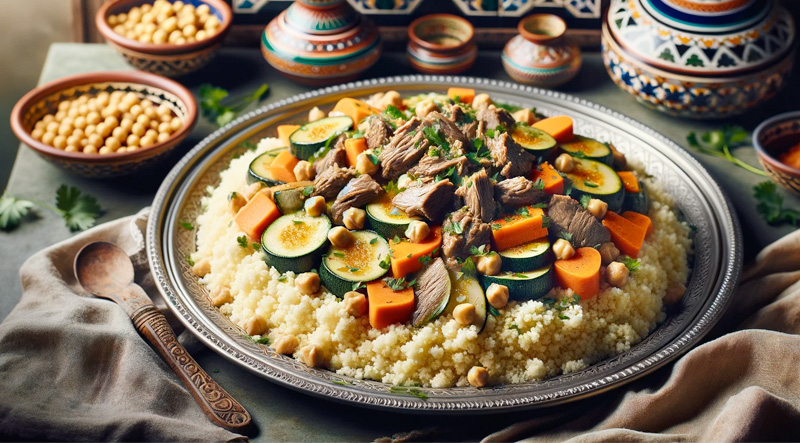Algeria's national dish is Couscous, a traditional Berber dish. Couscous is made from small steamed balls of crushed durum wheat semolina, and it is often served with meat, vegetables, and various spices. The dish is a staple in Algerian cuisine and holds cultural significance, being a common dish for gatherings and special occasions. The preparation and ingredients can vary by region, reflecting the diverse culinary traditions of Algeria. Read More...
Exploring the Culinary Heart of Algeria: A Journey Through Couscous
Introduction
In the rich tapestry of global cuisine, each nation has its hallmark dish that embodies its cultural and gastronomic heritage. For Algeria, this dish is unquestionably couscous. This delectable staple, deeply rooted in Algerian tradition, is not just a meal; it’s a cultural symbol, a connector of people, and a story of the country’s history and diversity.
The Origins and Significance
Couscous, originally a Berber dish, has a storied past that traverses centuries. Made from small steamed balls of crushed durum wheat semolina, it is a testament to the ingenuity of ancient North African agrarian societies. It’s not merely a dish but a culinary ritual that brings families and communities together. In Algeria, couscous is more than food; it’s an expression of hospitality, a centerpiece at gatherings, and a celebration of life’s milestones.
The Preparation: A Labor of Love
The preparation of couscous is an art in itself, often handed down through generations. The semolina is laboriously steamed in a special utensil called a ‘couscoussier’ and is meticulously fluffed to achieve the perfect texture. This process, often communal, is as much about bonding as it is about cooking.
Regional Variations: A Palette of Flavors
Algerian couscous varies significantly from region to region, each adding its unique twist. In the coastal areas, couscous might be served with fish and a tomato-based sauce. The inland regions might favor lamb or chicken, cooked with a melange of vegetables like carrots, zucchini, and chickpeas. Spices, too, play a crucial role, with blends like Ras el Hanout adding depth and warmth to the dish.
The Modern Algerian Table
Today, while traditional methods still thrive, modern influences have crept into couscous preparation. Contemporary kitchens might use instant couscous, cutting down on preparation time, and experimenting with new ingredients and flavors. However, the essence of the dish remains, continuing to be a unifying force at the Algerian table.
Conclusion
Algerian couscous is more than just a national dish; it’s a narrative of the country’s history, culture, and community spirit. It’s a dish that tells stories, encapsulates traditions, and brings people together. In each grain, there lies a piece of Algeria’s soul, making couscous not just a meal but an experience to be cherished and shared.
This article offers a glimpse into the heart of Algerian cuisine, inviting readers to appreciate the depth and diversity of this simple yet profound dish. Whether enjoyed in a humble home kitchen or a grand festive gathering, Algerian couscous remains a timeless tribute to the country’s rich culinary heritage.
Prepare the Couscous:

Cook the Meat (if using):
Make the Vegetable Stew:

Serve:
Enjoy your traditional Algerian Couscous, a dish rich in flavors and perfect for a family meal or a special occasion!
The preparation and cooking time for the Algerian couscous dish varies depending on the inclusion of meat. Without meat, the total time is roughly 1 hour and 15 minutes to 1 hour and 35 minutes, accounting for 20-30 minutes of preparation and 55-65 minutes of cooking. If meat is included, the total time extends to about 1 hour and 40 minutes to 2 hours and 10 minutes, considering the additional steps of browning and cooking the meat. This estimation includes chopping vegetables, preparing couscous, and simmering the stew, and may vary based on individual cooking speed and methods.
The traditional Algerian couscous dish, as per the recipe provided, can vary significantly in calorie content based on its ingredients. A vegetable-only version totals approximately 1271 calories for the entire dish, considering the couscous, olive oil, assorted vegetables, chickpeas, and canned tomatoes. If meat is added, such as lamb, the total increases to around 2396 calories, while using chicken instead brings the total to about 2014 calories. These calorie counts are for the whole dish; thus, the calories per serving would depend on the number of servings prepared. For example, if divided into four servings, each would contain roughly 318 calories for the vegetable version, 599 calories with lamb, or 503 calories with chicken.







